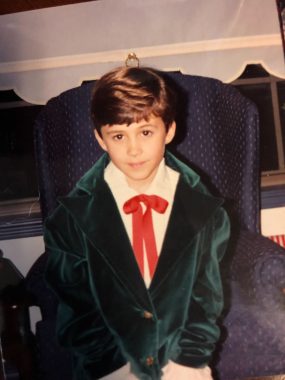How an FA Patient Came to Play Fritz in ‘The Nutcracker’
Memories of a Christmas ballet and giving life to a well-known part

A news article was recently shared and reshared across my social media platforms. It reported that a 9-year-old girl recently performed in an Oklahoma production of “The Nutcracker,” composed by Tchaikovsky.
Typically, there’s nothing newsworthy about that. “The Nutcracker” almost always features children in its first act. But this girl has Friedreich’s ataxia (FA), a rare neurological condition affecting coordination and movement. Since FA is progressive and has no cure, an older patient might have trouble participating in a ballet. Therefore, it’s endearing to read that this girl, Olivia Francis, was able to participate.
But it’s also somewhat discomfiting for me.
I’m a bit uncomfortable because some might assume that Olivia is the first child with FA I’ve heard of who was cast in “The Nutcracker.” But she isn’t.
I am.
Let me explain
I’ve never had any interest in dancing or ballet at all. Here’s how I found myself cast in a regional production of the most well-known ballet in the world.
I took gymnastics in the same facility where my sisters took dance. In 1994, one of their instructors had a question for my parents. She was directing “The Nutcracker” and thought 9-year-old me would be perfect for the part of Fritz, the brother of the lead role of Clara.
Though no one ever said this, the director probably selected me to play Fritz because of my FA diagnosis that year. At 9, I had no obvious symptoms except during strenuous physical activity. Since this role had no running or jumping, it seemed ideal for a boy who may not be center stage once his disorder progressed.
No one used the word “ballet”; I was chosen to be in a “play.” The idea of a ballet, full of pink leotards and tutus, was repulsive to my young Cajun sense of boyhood.
That’s how I accepted the role of Fritz, the bratty younger brother who breaks the titular toy in a fit of jealousy.
Maybe I should be offended that I reminded the director of Fritz.

Matt Lafleur, ready to perform opening night. (Courtesy of Matt Lafleur)
The long con
Every Saturday in the fall of my third-grade year, I’d join the caravan of other locals driving an hour north to Alexandria, Louisiana, to rehearse our roles in the “play.” I don’t remember anyone calling this production a ballet around me.
Looking back now, I missed some obvious clues that I wasn’t in a play. The production company was the Alexandria Ballet Company. (Now it’s known as the Red River Dance Theatre Company.) The entire “play” had no dialogue, and my part consisted of steps and movements timed to music.
The most obvious clue was during the opening week, when we castmates signed each other’s freshly printed programs. A boy my age who was with me in the opening party scene, my buddy on my side when I broke the nutcracker, signed my brochure with “From Wade, the best dancer.”
“Why the heck would he write that?” I wondered, but shrugged off my confusion and didn’t dwell on it.
I never claimed to be very bright.
Whether because of purposeful ignorance or lucky stupidity, I conned myself. I was a well-known character in a ballet and didn’t even realize it.
Sharing space with the Rat King and Sugar Plum Fairy
I was glad to read that Olivia was performing in the Oklahoma “Nutcracker,” even if it reminded me of when I was unknowingly in a ballet. Or maybe the story makes me glad because it reminds me.
Maybe that Oklahoma girl playing with the Christmas toys has a lesson to teach this onetime Fritz.
I’m grateful that I believed I was in a play back then because if not, there’s no way 9-year-old Matt would have participated in a ballet; I would’ve thought ballets were girly, plus all my classmates would’ve made fun of me.
Even so, there’s no denying that I cherish my memory of being in “The Nutcracker.”
Since living with FA means that our physical abilities will keep worsening until researchers discover a treatment that can slow or stop disease progression, extraordinary memories are fundamentally important. They comfort us as our disability progresses.
Maybe soon the FA community will have more than memories to treat disease progression. Research for this incurable disorder is ramping up. The promising treatment for my disorder may even be approved next year. Who knows?
Finale
At the end of every performance of “The Nutcracker” in 1996, I was the only kid, besides the girl playing my sister Clara, from the opening party scene to return to the stage for the curtain call. After two rounds of applause, I’d run from behind the curtain to center stage, shamelessly point to myself, then the performers playing my Uncle Drosselmeyer and sister Clara would take a bow with me.
I got applause in a ballet.
Maybe it’s not all pink shoes and tutus.
In my memory, for one round of applause, I was the man.
Note: Friedreich’s Ataxia News is strictly a news and information website about the disease. It does not provide medical advice, diagnosis, or treatment. This content is not intended to be a substitute for professional medical advice, diagnosis, or treatment. Always seek the advice of your physician or another qualified health provider with any questions you may have regarding a medical condition. Never disregard professional medical advice or delay in seeking it because of something you have read on this website. The opinions expressed in this column are not those of Friedreich’s Ataxia News or its parent company, Bionews, and are intended to spark discussion about issues pertaining to Friedreich’s ataxia.








Leave a comment
Fill in the required fields to post. Your email address will not be published.